The Wet Season — What to Expect
Unless you have spent a substantial amount of time in the tropics, it is unlikely that you have ever experienced anything like our wet season. It does not resemble the weather you get in temperate climates. Television weather reports lie. They do not do so intentionally, but the symbols they use were all designed for other climates. Looking at the TV weather reports, many people get the impression that it rains all day, every day. That's almost as far from the truth as saying it doesn't rain at all.
There are far too many photos on this page but we believe it is important to give people as good a picture as possible so that those who do come will come prepared for the conditions that they encounter and leave with wonderful memories that will last a lifetime — or at least until their next wet season trip.
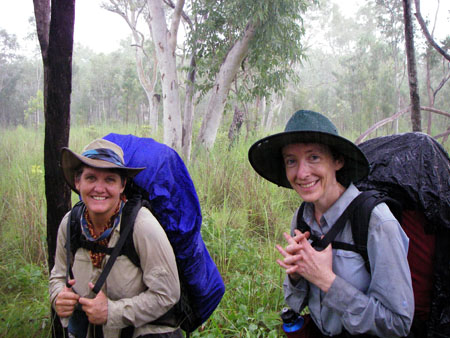
If you do a multi-day walk in the wet season, you are going to get wet. However, getting rained on in the tropics is
a far different experience to getting rained on in a cooler climate. Look at the people in the photo at right. It
is pouring with rain. They are not wearing rain coats. They are soaked. Do they look miserable? No!
They are smiling. Tropical rain is different. Walking in the rain can be enjoyable;
a raincoat can become an unnecessary weight. 'Breathable" fabrics don't breathe when it's warm so you'll get wet anyway. Why not relax and enjoy it?
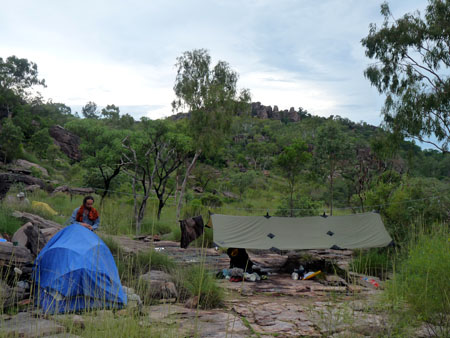
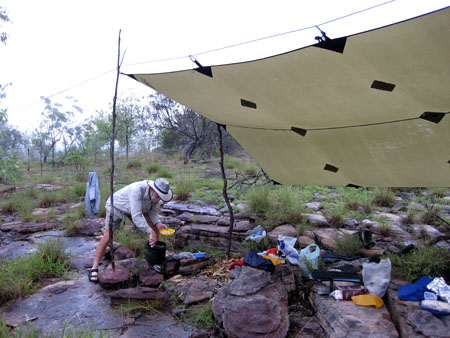
But what happens if it's raining when it's time for dinner? Worse, what happens when it's raining when it's time to put up or take down your tent? The answer may come as a surprise.
You can sit in the dry for dinner. You can put up you tent in the dry. The secret is our group fly, shown at left on two different Kakadu trips in January.
If it's raining when we set up camp, we put up the fly. If you have a free-standing tent, you can put it up in the shelter of the fly, then bring it out into the rain without getting it wet inside.
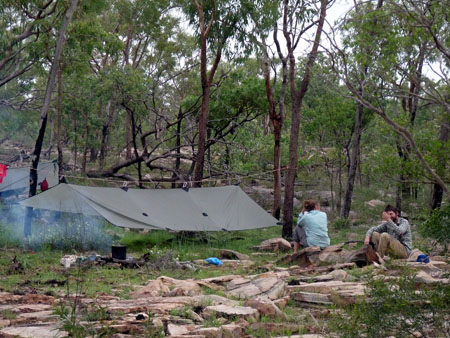
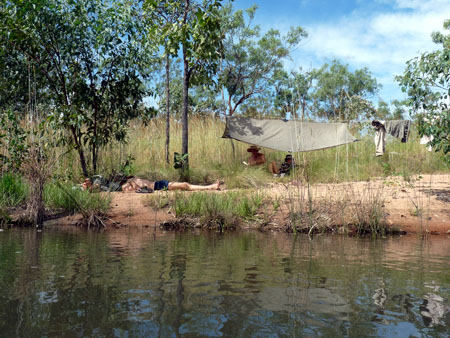
There's more. If it's really bad, we can actually cook under the fly. And, if we don't have enough shade at lunch time, we can use the fly for a bit of extra shade for relaxing.
Campfires in the rain? Campfires are our preferred means of cooking. It doesn't always work. In the 25 years that we've been operating, there have been two times when the guide couldn't get the fire going for dinner so the group had to eat their breakfasts that night and dinner in the morning. Twice in 25 years — that's not bad.
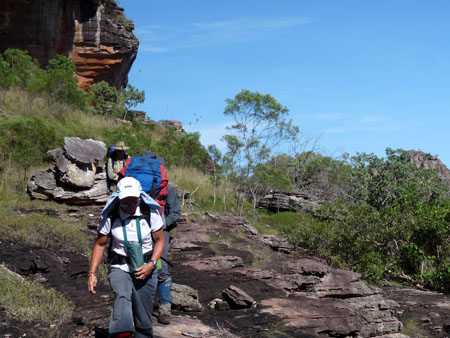
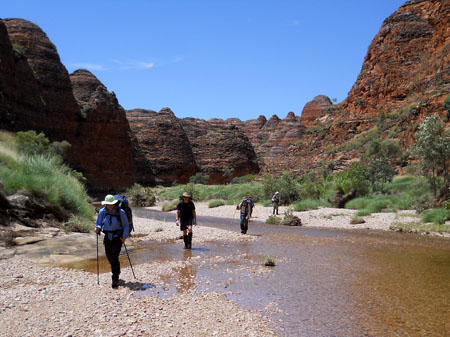
Blue skies. Contrary to popular belief, the skies are not always grey. As shown at left, sometimes there is hardly a cloud to be seen. The far left photo is Kakadu in January; the other is the Bungles in February.
The rain, when it comes, normally comes in short sharp bursts, over in minutes or at most a couple of hours. Occasionally a monsoonal depression can being rain that lasts for days, but even then, there are breaks.
The waterfalls. The contrast between the Wet and the Dry is amazing. The four pictures below are of Jim Jim Falls. The two at left are of the main falls, the first in January, the second in August. In January, we couldn't get to the point where the dry season photo was taken.
The two photos at the right are of the centre drop of Jim Jim Falls. Both were taken from approximately the same point — the first in January, the second in October. It's a lovely sunset, but not a drop is coming over the falls.
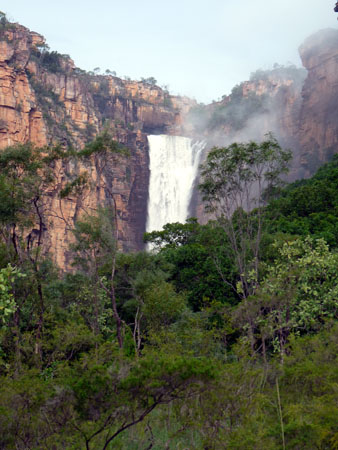


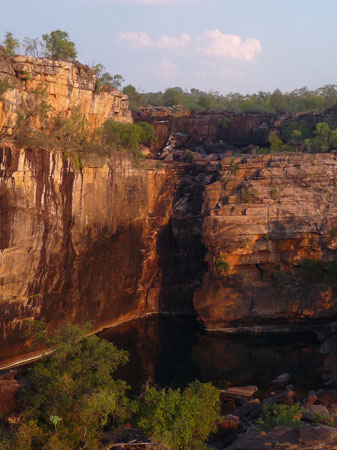
You don't have to wait until late in the year to see a dramatic difference. The two photos at left below show the main falls at Graveside. The first is in January, the second is in May. By August, one drop will be a tiny trickle and the other will be bone dry.
The two photos at right are in the Carr Boyd Range in the Kimberley, taken from almost the same point. The first was taken in January, the second in May. It's hard to believe they show the same location.
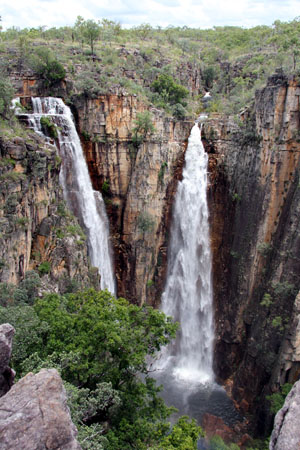

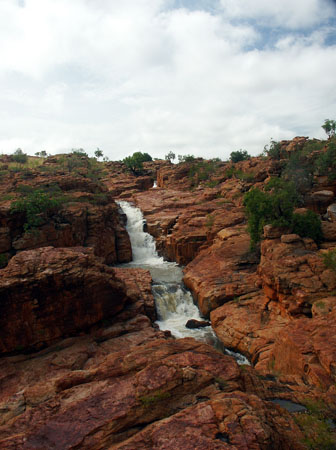
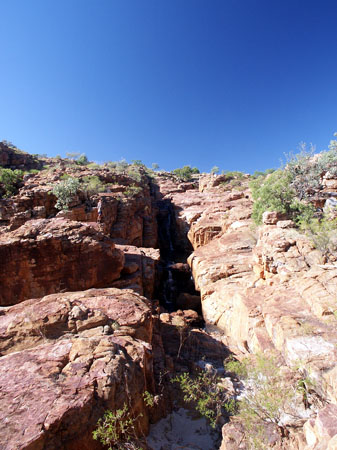
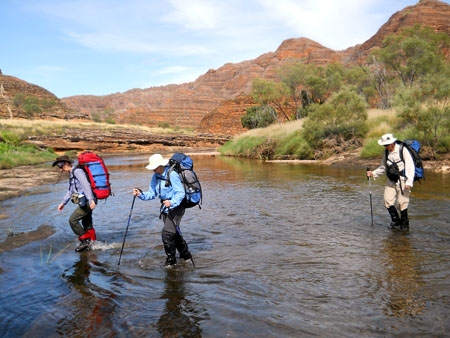

On all of our wet season trips, you are going to be walking through water. Sometimes, as in the Bungles photo at far right, the water will be shallow. Sometimes as in the nearer Kakadu photo, it will be deeper and more difficult.
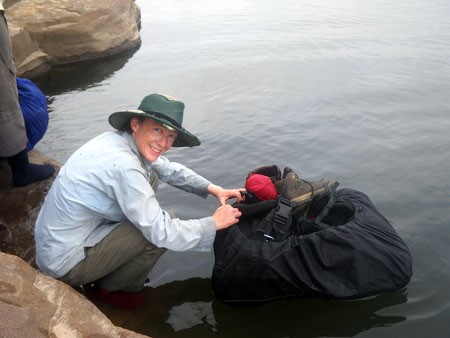
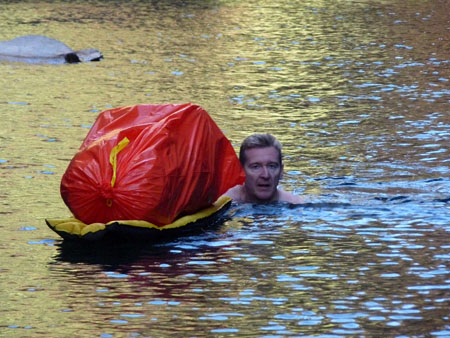
Wading is not always enough. On the longer expeditions you might have to float your pack. These are the expeditions for which the ability to swim is an absolute must.
The easiest way, if you have the right gear, is to float your pack in a pack cover as shown at right. If you want to make absolutely certain that everything stays dry, you can put your pack into a garbag and put the garbag onto an airbed as at the far right.
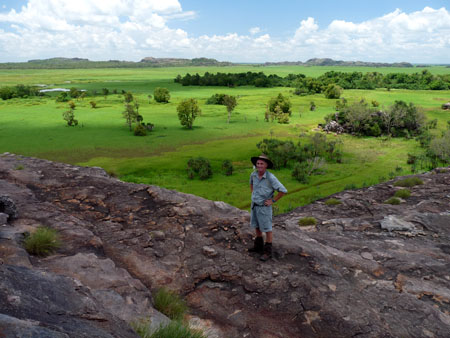
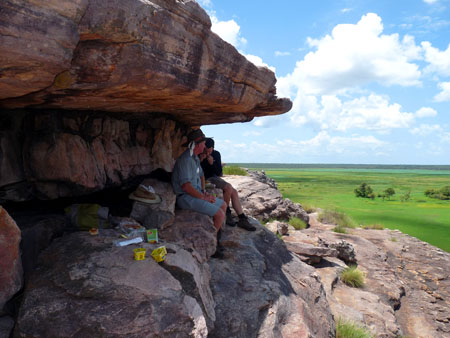
For those who have come north in the dry season, one thing that seems even more remarkable than what they see is what they don't see — people.
The two photos at right were taken at Ubirr in February 2011. In the dry season, the landscape would be no where near as green and you'd share the views with up to a hundred other people. Occasionally there would be even more. There were only six of us present when the photos were taken.
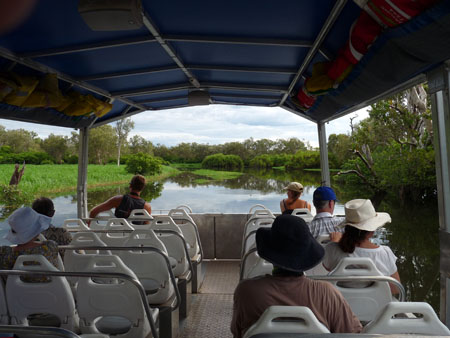

There are no crowds anywhere. The photo at far left is on a Yellow Waters cruise in Kakadu in February. In the peak of the dry season, there would be three or four boats running at the same time and they would all be full. In february, there was only one boat and it was less than a quarter full.
It's not just Kakadu. The photo at near left is Cathedral Gorge in the Bungles. This is the most popular short walk in the park. Not only did we have it to ourselves, we had a flowing waterfall, something the dry season tourists never see.
It's not just the big picture. The little things are a big part of what makes this a very special time of year.
Flowers are in bloom for the entire year, but they are at their best during the Wet. Insects and small animals can be a delight. An incredible variety of fungi appear in the damp conditions.
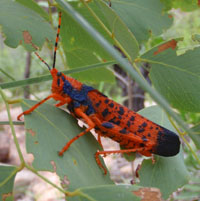



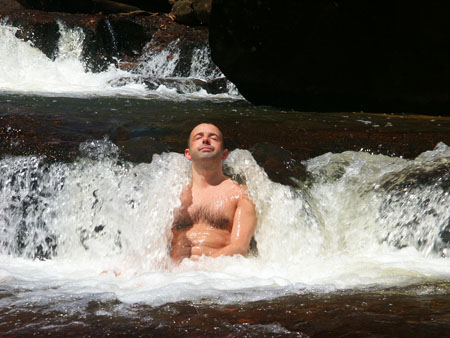
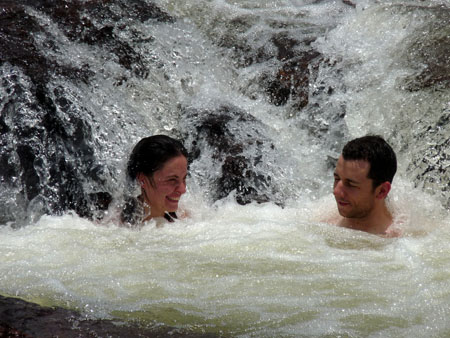
Pure bliss. The swims are pure bliss. The water temperature is ideal for just sitting and relaxing.
The people in the photos at the right, taken in January and February in Kakadu, are enjoying themselves.
Why not try a wet season trip and experience the magic of our tropical summer for yourself.
Stop! You are not quite ready to book a trip yet. We want everyone who comes on one of our wet season trips to be properly prepared so that they can enjoy it as it is meant to be enjoyed. Have a look at our preparing for your wet season trip page. It is full of information that will allow you to get the most out of your trip.
 share
share